|
Conversations With
A
Native Plant Woman
(and Friends) |
| |
This is a
collection of excerpts from the home pages of the Wild Garden and
the old Hansen Nursery websites. Some were written by Wally Hansen
and one or two were penned by his daughter, Diana Hansen-Young, but
most were mine. They are in reverse chronological order going back
from this year to 2002. They reflect
plants of particular interest, the seasons, garden activities, and
local or world events prominent at the time of writing.
It is doubtful anyone would ever print these
on fine linen and have them bound in leather, but you may find them
interesting or humorous or helpful.
Use the links below for particular dates of
writing, or simply scroll down through them. |
|
2012
April 5, 2012 |
2010
December 23,
2010
December 3,
2010
November 26,
2010
October 29,
2010
October 22,
2010
October 7,
2010
June 6, 2010
May 28, 2010
April 10, 2010 |
2009
December 6,
2009
November 18,
2009
October 18,
2009
September 9,
2009
August 22,
2009
June 12, 2009
June 6, 2009
May 13, 2009
March 6, 2009 |
2008
August 16,
2008
July 19, 2008
June 15, 2008
May 3, 2008
April 17, 2008
April 4, 2008
March 26, 2008
January 23,
2008 |
2007
December 2,
2007
November 20,
2007
October 21,
2007
October 1,
2007
September
12, 2007
September 3,
2007
April 1, 2007 |
2006
December 24,
2006
November 21,
2006
November 11,
2006
October 21,
2006
April 10, 2006 |
2005
December 30,
2005
December 02,
2005
November 25,
2005
August 20,
2005
August 5, 2005
2004
July 23, 2004 |
2003
November 28,
2003
November 14,
2003
October 18,
2003
August 21,
2003
July 24, 2003
February 6,
2003 |
2002
November 28,
2002
September
13, 2002
May 17, 2002
April 27, 2002 |
|
|
h
2012
h |
|
From Jennifer, April 5, 2012
The official start date of spring has passed. For some reason nature does
not agree. Or maybe she just has a different viewpoint of what spring is
supposed to be like. Anyway, at right is my side yard when I woke up on
Thursday, March 22. It snowed lightly all day and into the night. The next
morning it was at least an inch deeper. I was delighted of course. When one has
no reason to venture out into snowy weather, it is a lovely thing. The quiet of
early morning with a fresh snow is a pure peace. So, thanks to nature for a
memorable surprise.
The
rhodies are waking up. New branches started last spring are sporting buds
that are filling with flowers to be. They are still flinching from the cold but
nothing serious. The birches have little catkins along their branches. The
sword
ferns are in perfect health. And every day Maggie and I walk all through the
garden to see what has happened while we slept. Today's surprise was Bleeding
Heart (Dicentra formosa). A very respectable population of them has come up
just inside the Giant
Arborvitae (Thuja plicata) hedge
at the southern edge of my garden. The photo below right was taken this
morning.
I don't know what the cement blocks are for. The woman who planted this amazing
garden has these all around the place in what are precise configurations but I
have no idea what they are for. It is difficult to let them alone but I've
learned from past experience that it takes a year to see all that a garden has to
offer. Any digging or moving things about is liable to smash some perennial or
bulb or who knows what that may be still asleep. I will put a Chinese lantern on
this cement square for the time being.
|
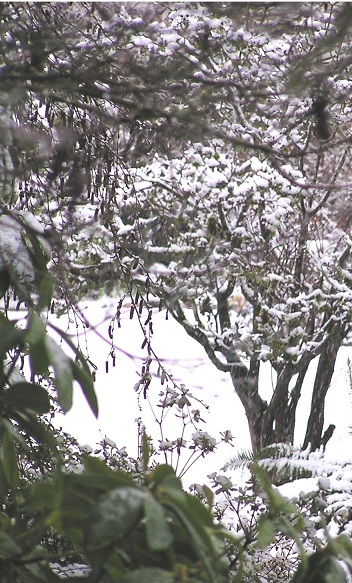
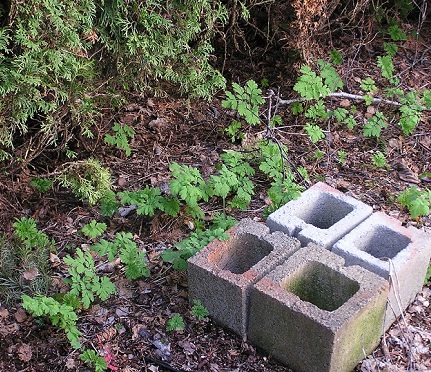 |
|
h
2010
h |
From Jennifer, December 23, 2010
It's almost here!!!! Even though every year has a December with a magical day,
the winter holidays will at some point infect us with their 'spirit.'
And it's more than the pure fun of choosing just the right gift for each of
our 'someone's.' For me, catching the holiday spirit may be triggered by the twinkly lights
and rich aromas and sparkling decorations; or the smiles that warm from the
inside;
Maybe it's the people--standing in line or thumbing through a pile of
interesting items--humming or quietly singing or tapping a toe in time with
White Christmas or Do you hear what I hear? coming from an invisible orchestra. Or it could be catching a whiff of cinnamon/apple/cranberry/cedar, or
frankincense, or myrrh.
Regardless which of these things transport us from the everyday world to
joyful holiday cheer, all are elements to be enjoyed
|
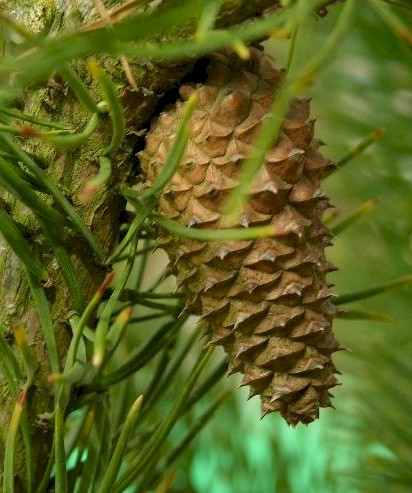 |
From Jennifer, December 3, 2010
Winter holidays are upon us. There are lots of scurryings to and fro. From the
oven come mouth-watering scents of cinnamon, chocolate, peppermint. And bells
and buckets greet us at grocers, clothiers and single destination emporiums.
This morning we (my dog and I) stood listening to what sounded like an entire
squadron of little birds singing their joy at some discovered feast in a
neighbor's tree. I couldn't make out what menu item caused such jubilance. It
looked like an ordinary evergreen tree to my human eye. What made this tree
today's gourmet delight when just yesterday it held no such attraction?
Perhaps Bob and Julie had hung bird treats among the branches of the
Incense
Cedar--maybe suet cakes or seed bells or peanut butter pinecones. Whatever the
reason, the little birds certainly brightened our early morning trek to our
backyard haven.
We were not alone in observing this feathered frolic: one of the neighborhood
squirrels was perched on a branch of our
Doug Firs (Pseudotsuga menziesii var.
menziesii). He quietly watched and listened as the little guys chirped and sang
and flitted about, seemingly without any thought of crashing the party. I bet he
went for a closer look after the bash was over.
|
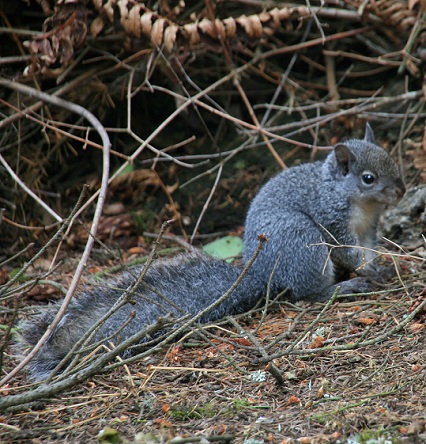
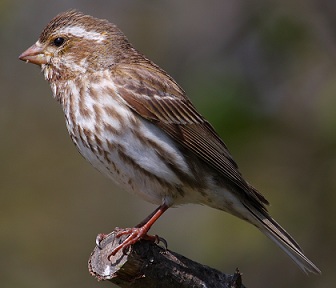 |
From Jennifer, November 26, 2010
What an enchanting day we had for the thankfulness holiday! 'Twas beautiful here
in the Valley--chilly but not too cold--unless you were out in it. The news
showed some of the people who devoted this day to lending a helping hand (for
some it is an honored tradition observed each year). It is very uplifting to
hear their stories and meet some of the recipients of these gifts of love. Let
us keep these memories and acts of kindness today and all our tomorrows.
Nature XXVII, Autumn
The morns are meeker than they were,
The nuts are getting brown;
The berry's cheek is plumper,
The rose is out of town.
The maple wears a gayer scarf,
The field a scarlet gown.
Lest I should be old-fashioned,
I'll put a trinket on.
~ Emily Dickinson
Make your house smell good! Use
fragrant greenery of northwest native plants for holiday hall decking. Boughs of
fresh-cut trees and cuttings of shrubs that are naturally aromatically
delightful will serve you well in both beauty and air freshening. May we
suggest:
Green tip: After the holidays, use the dead materials
from natural wreaths,
holiday trees, swags, etc. as insulation/protection for tender plants and/or
those planted during the year.
And whatever is left of these come spring can be incorporated in the compost
heap.
|
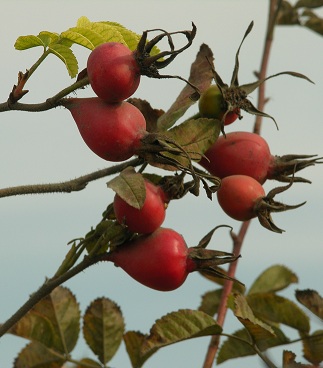
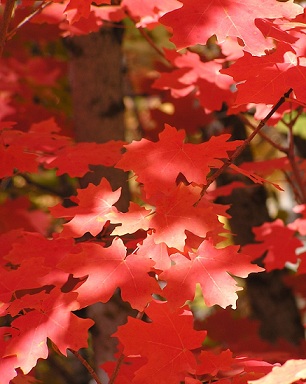
Photo
credit: Scott Catron
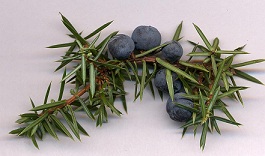
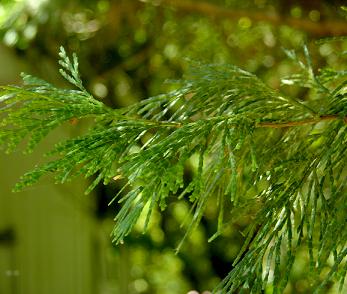 |
From Jennifer, October 29, 2010
Blustery days! I love them. They give such a good excuse to wear colorful boots
and use an umbrella (two of my favorite wardrobe items). And if you come across
a good-sized puddle, it is considered proper behavior to stamp right in the
middle where it's deepest but care must be taken not to splash anyone unless
they say it's OK.
The trees in my back yard have all dropped their leaves which I carefully
allow to remain where they land. By next spring they'll be all composted and
ready to spread around the perennials, keeping down weeds and enriching the
soil.
The folks whose backyard adjoins mine have planted a group of five poplars.
They're about 10-12 feet tall now and have really put on a colorful show this
fall. Now that my trees are barren of foliage I have a lovely view of the
brilliant gold and red poplar leaves. In the evening, the sun hits them just
before it slips below the horizon, setting those rich colors afire with the
day's last beams of light. I have not yet figured out how to capture this on my
digital camera. I may have to change mediums to water colors.
Oregon State University is currently researching the possibility of using the
seed hair fibers from Oregon's poplars for thermal insulation products such as
comforters. The seed hairs are "soft, fine and extremely lightweight," all
positive characteristics for this type of textile. Read about this work on the
Textile Insight website at
www.textileinsight.com/articles.php?id=567.
Photo credit: The High Fin Sperm
Whale
|
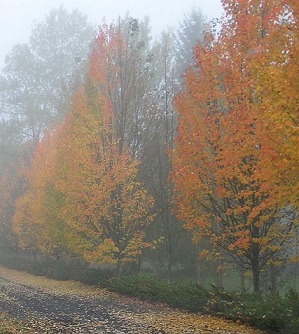
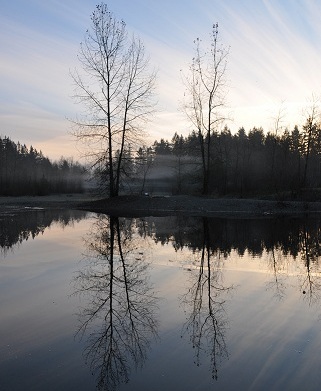 |
From Jennifer, October 22, 2010
The beautiful late autumn days are predicted to end (or at least greatly
diminish) soon. My pal Jodie and I took a stroll outside a little while ago to
see what was happening. It is so warm today! Taking a tip from the weather
experts, I covered the patio furniture, pushed the wheelbarrow into the shed and
did a little bit of tidying up.
Jodie, as usual, ran around the perimeter of the yard and then took a few
detours to her favorite spots. She does this each time we go out. She has
appointed herself the General Inspector. She has her nose next to the ground as
she quickly races along, one eye always cocked up to watch ahead and the other
eye riveted to the ground so she can see what she's smelling.
Our chores done, we admired the newly fallen leaves. We discovered a slug
under one of the maple leaves. It wasn't active enough to engage Jodie but I was
properly disgusted, not being a fan of the slimy things. I took my potted
Lewisia out of it's decorative pot and nestled it down beside the eastern wall
of the raised pond. It has spent every winter there since Wally gave it to me.
It has two new pups this year--I turned the pot so they will get the best
shelter.
I hope you are taking time to get outside during these delicious autumn days.
Take a break! Whatever you're doing can wait a few minutes while you breath some
fresh air.
|
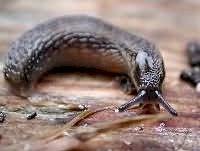
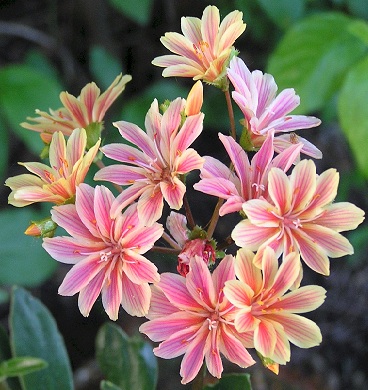 |
From Jennifer, October 7, 2010
The annual show of fall color is once again beginning all around us here in
Oregon's Willamette Valley. Smooth Sumac (Rhus glabra), shown at right, is one
of the first natives to color up with each leaf progressing from green through
gold to orange and finally to brilliant scarlet.
All through October to November, each plant takes its turn in the spotlight.
Each shrub and tree has its own natural agenda and its unique color scheme from
start to finish.
Deciduous plants end their show by dropping the now colorful leaves to the
ground below. Some evergreens also change colors as summer turns to fall and as
fall goes into winter, but they omit the overall leaf drop.
For example, our state flower,
Tall Oregon Grape (Mahonia aquifolium), has a truly
remarkable color sequence that begins with new growth of bronze. Then those
bronze leaves change to deep rich green through spring when the bright yellow
aromatic flowers are displayed. By the beginning of winter, some of the leaves
sport bright red shades with margins of green while the fruits are dark blue.
Amazing and natural.
Of course, an evergreen plant that changes leaf color is the exception and
not the rule. Most evergreens do exhibit some differences in appearance as the
seasons change, however these usually involve blooms or seeds rather than leaf
color. For the most part, the autumn leaf phenomenon is in the court of
deciduous plants.
|
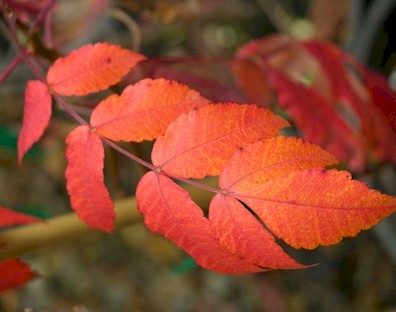
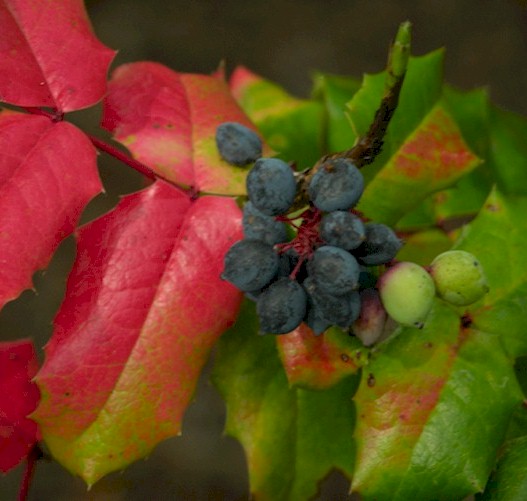 |
|
From Jennifer, June 6, 2010
The
weather this morning is about as close to my version of perfect as it
can get:
 |
Temperature = 60 degrees F |
 |
Sky = cloudy |
 |
Wind = at a standstill |
 |
Rain = missing |
And the prediction for tonight is
rain, tomorrow it's rain with some wind.
Translated to gardening language:
perfect! Plant, pull weeds, trim and admire. Head indoors when you get
done or the first rain falls, whichever comes first.
After a shower and clean clothes, I
like to sit under the covered patio with a nice cup of herbal tea and
make plans for my garden. I find this especially nice when a gentle rain
is falling. Watching mother nature water-in the plants I've just added
to the garden is so peaceful. Each raindrop soaks into the ground,
taking a modicum of dust with it. If the shower is soft enough (and I've
prepared the soil enough), there will be few puddles lasting more than 5
minutes or so. Weeds!
Why is it, do you suppose, that the same soil in our gardens that must be
treated fairly and well to ensure proper health of our plants is so adept at
growing the most healthy weeds in the universe all on its own with nary a drop
of moisture aside from that which nature supplies?
A week ago the small undeveloped patch of bare dirt sported a mere handful of
weeds less than an inch tall. Today that little patch has so many weeds it would
take all day to count and every one of them is at least a yard high.
My garden is tended by hand and in harmony with the earth. That means
somebody has to bend and stoop to pry out the weeds while leaving as much dirt
as possible on the ground. Right now this is an easy and rewarding chore. The
roots are young, the soil is loose, and nothing has gone to seed. In a month,
that scene will have shifted to a battlefield and nobody will be having any fun.
All philosophy aside, if you have a yard or any sort of outdoor gardening
space now is the time to get those weeds gone! Just do it! Pull them and compost
them and use the resulting 'black gold' to mulch as soon as it's ready.
TIP: If, for some reason, your weeds are recalcitrant about being pulled up,
water the area well and deeply and pull them the next day. Alternatively, just
cover the area with plastic and let nature cook the weeds. By planting time next
fall the weeds will have composted and the dirt should be ready for you.
Ponderings
We had a bit of a stir last evening when I took the dogs out for their last
hurrah. No sooner had we got past the threshold than a covey of crows set up a
racket as only crows can do. Between their raucous alarm and the dogs seeing who
could get there first and my little cane-assisted quick-step, all able bodies
were heading for a spot beside the garage.
Sure enough, one of the crows was lying wounded just inside the garden gate.
Everybody went quiet while I examined her. She watched me with hope in her eye.
Sadly, she was near the end of her road. I placed her on a pile of soft weeds
outside the fence, wished her good journey to the other side and left her in
nature's hands. Neither she nor her friends nor the dogs said another word. The
crows held all further remarks as the dogs and I quietly went inside.
There's something profound about a scenario such as this one. Every soul
present entered a circle of one mind. Each was held in utmost respect by the
others. No words were spoken, none were required.
|
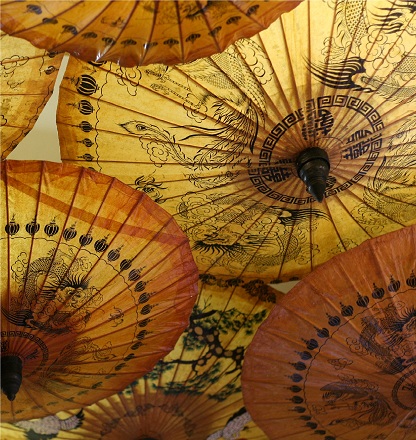
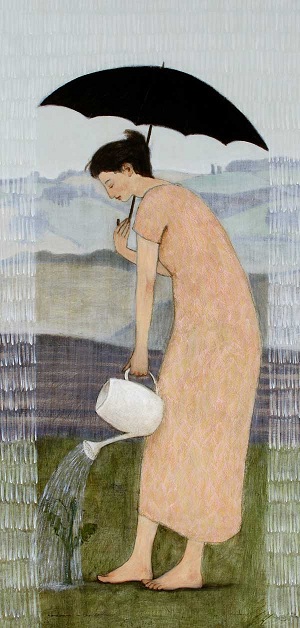
Gardening in the Rain
Painting by
Kershisnik
www.matterpattern.blogspot.com
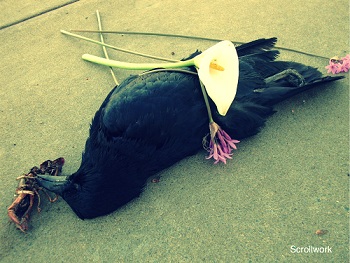
What the
crow missed
by dying
today
Scrollwork blog
Tuesday, April
26, 2011
www.scrollwork.blogspot.com/
2011/04/what-crow-missed-
by-dying-today.html
|
From Jennifer, May 28, 2010
The Oregonian's home and garden daily tip last Tuesday featured a very bold
member of the finch family who struts around wearing Oregon State University's
trademark colors of orange and black. Now, that is really "putting your money
where your mouth is," as the saying goes.
This fellow decided to patrol a pot of
Camas where JoAnn happened to be
photographing flora and the occasional fauna at the nursery.
According to Cornell's Lab of Ornithology, spotting Mr. Towhee was a stroke
of luck:
". . .your best chance for an unobstructed look at this handsome bird may be
in the spring, when males climb into the shrub tops to sing their buzzy songs."
And that's exactly what happened (after a
fashion). Well, a pot full of Camas evidently qualifies as a shrub top. Easier
footing, as well.
If you'd like to have Spotted Towhees visit your yard, provide some
berry-bearing shrubs, some shrubby bushes and make do with fallen leaves beneath
shrubs as a mulch. Once established this small habitat will take care of itself
with little assist from the gardener. Then sprinkle seeds right on the ground
where towhees prefer to dine. Now mind, don't put just any old seed down. It is
likely the foraging towhees will miss a few seeds here and there, so use seeds
of plants you wouldn't mind cropping up.
Birdsong is not the only benefit of luring these colorful birds to your garden.
Feast your eyes on this list of towhee favorite treats:
|
Ants
Beetles
Caterpillars
Lizards
Millipedes
Moths |
Small salamanders
Snails
Snakes
Sow bugs
Spiders |
Per The Oregonian: "For
vegetables, feed them [towhees] weed and grass seed, and top it off with
any wild berry dessert." About those berries, may we suggest wild
strawberries and any of these
northwest native shrubs:
|
Bearberry
Blackcap
Blueberry
Gooseberry
Huckleberry
Salmonberry |
Serviceberry
Snowberry
Squashberry
Thimbleberry
Wolfberry |
See Cornell's All
About Birds website at
www.allaboutbirds.org/guide/Spotted_Towhee/id
Photo credits: Bearberry by Sten Porse, Spotted Towhee by Walter Siegmund
|
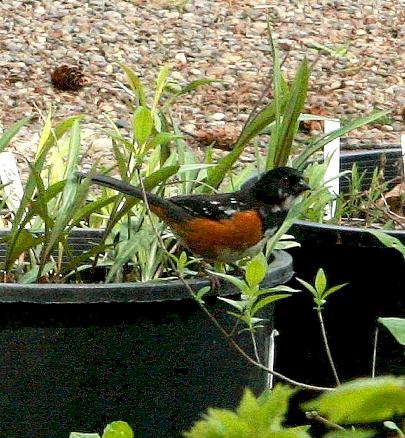
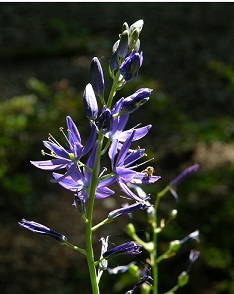
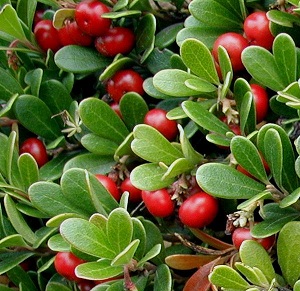
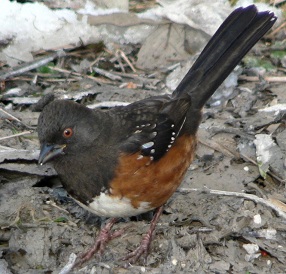 |
|
From Jennifer, April 10, 2010
Gardening with natives is the best of both worlds:
-
Native plants in the landscape are every bit as
attractive as non-natives.
-
Native plants require less water, less care and are much
more pest-resistant than non-natives.
As I walk through my garden, I ponder upon the fact that
the same species of plants available today were here before any explorers set
foot on our soil gives a sense of harmony with history.
Though the plants were here long before the botanical
pioneers came calling, it was those folk of olden times who gave each specimen
their scientific names. And very often the plants bear the names of their
discoverers. For example:
David Douglas (1798 - 1834),
Douglas' Spirea (Spirea douglasii)
Dr. John Scouler (1804 - 1871, Scouler's
St. Johnswort (Hypericum scouleri)
Thomas Jefferson Howell (1842 - 1912),
Cluster Lily (Brodiaea howelli)
Thomas Nuttall (1786 - 1859),
Pacific
Dogwood (Cornus nuttallii)
Sir William Jackson Hooker (1785 - 1865),
Hooker's Fairy Bells (Prosartes hookeri)
Archibald Menzies (1754 - 1842),
Pacific Madrone (Arbutus menziesii)
Meriwether Lewis (1774 - 1809), the plant
genus Lewisia
William Clark (1770 - 1838), Pink
Fairies (Clarkia pulchella)
|
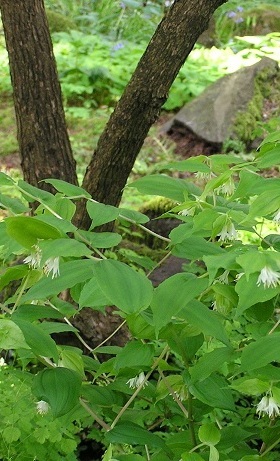 |
|
h
2009
h |
From Jennifer, December 6, 2009
'Tis holiday time once again. City streets have wreaths and bells decorating
lamp posts. The stores are all done up with shine and sparkle and seasonal
music. The 'red kettles' stand near the entrance to markets and shops, cheerful
volunteers ringing their bells to remind us to give a little extra for the warm
beds and meals they provide all year.
Shopping is usually a pleasant time right about now. The crush is not here
yet, last-minute madness is held in abeyance. More often than not, fellow
shoppers are in good humor and children are entranced with it all.
I've not made it to Willamette University's star trees yet but I will. The
annual lighting ceremony on Saturday brought visitors young and old to sip hot
chocolate, munch cookies and sing carols in the chill air. As the tree lights
came on, the transformation was complete.
The five
Giant Sequoias (Sequoiadendron giganteum) native to the northwest
were planted in 1942 to celebrate the university's 100th anniversary are simply
magnificent. The remarkable idea to plant these trees just as they are was a
most unusual plan. The trees now at maturity offer an entrancing sight: stand in
the center of the trees and look toward the sky to see the foliage at their tops
form a five-pointed star.
|
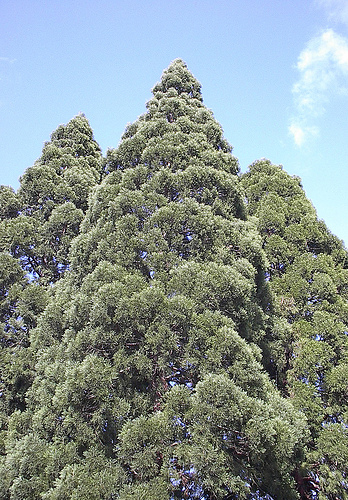 |
From Jennifer, November 18, 2009
Here we are on the downhill side of autumn with the usual wind and rain holding
court among the elements.
Traditional activities such as fall foliage tours, pumpkin carving and
Oktoberfests share billing among harvest festivals. We denizens of the northwest
are mostly unflappable when the weather puts a surprise spin on our plans.
The other day I was watching a man cleaning a parking lot with his leaf
blower. He didn't seem to notice that the leaves were not paying attention. He
whooshed them one way and the wind whirled them right back to the place they
were before meeting the blower. This is not an unusual sight but it is a most
curious thing to see.
Yesterday afternoon I took the dogs out for a little fresh air. They romped
and played and raced one another around, the same way they do all year--winter,
summer, spring and fall. It wasn't until they came over asking to go indoors
that I realized the 'rain' I expected was actually hail on their coats. They
seemed oblivious. Apparently rain and hail are identical forms of downfalls to
the mind of a dog.
They are dumbfounded when it snows, though. They jump up trying to catch it
in their mouths. No matter that they never seem to catch any, they do enjoy the
chase.
|
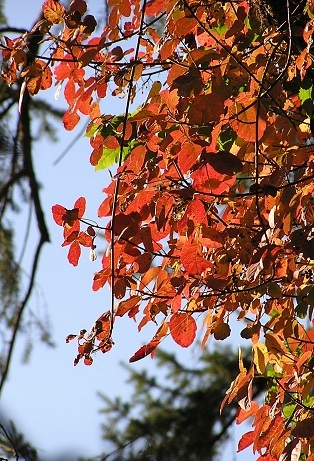 |
From Jennifer, October 18, 2009
Speaking of fall color, I noticed that nasty Poison Oak (Toxicodendron
diversilobum) along River Road the other day. For all the evil it does when
interacting with the skin of susceptible humans, it certainly does a bang-up job
of decorating the roadside.
The leaves are red--really red--maybe even more red
than Vine Maple or at least a respectable contender. And most of us can attest
to what a high level of autumnal splendor that is.
In fact, this plant is one of the two most poisonous on this continent. Each
season it displays beauty to lure us to it's treachery. Spring gets those leaves
all green and shiny, then the charming little flowers come on just begging to be
picked and put in a vase.
But the real devilment comes with the first flush of
fall when the high colour display begins. And to think it is native all along
the Pacific coastline.
|

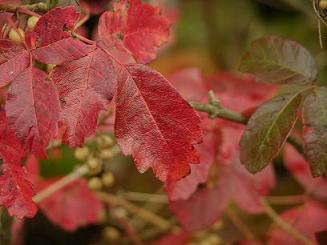 |
From Jennifer,
September 9, 2009
The straw hat I kept on a hook by the back door all summer has been replaced by
a wonderful satchel one of my daughters gave me on mother's day. It came with
some professional style hand tools, a fine pair of gardening gloves and it has
my name embroidered on the side. It's much fancier than anything I'd treat
myself to. In years past I'd have stored it away with other 'good' stuff to be
used on special occasions. But no more! I've decided that every single day is a
special occasion. I've thrown out the junky stuff, donated the second best items
and am using the very best every day. The time to celebrate life is now and I'm
celebrating in the garden.
|
 |
From Jennifer,
August 22, 2009
Miracles of Nature
Have you ever noticed how nature chooses different color schemes for the
seasons?
Late summer's colors are orange and red and golden yellow (with shades in
between, of course). I wonder why that is so. Are the tones in the hot zones of
the color wheel more attractive to birds and bees? Does nature select these
particular hues as an aid to self-preservation?
According to the U.S. Forest Service's website, Celebrating Wildflowers, the
flower colors are one aspect of nature's master plan:
"The flower type, shape, color, odor, nectar and structure vary by the type
of pollinator that visits them. Such characteristics are considered pollination
syndromes and can be used to predict the type of pollinator that will aid the
flower in successful reproduction."
Aha! The conspiracy between plants and animals is revealed! What an
interesting subject this is and how useful to the gardener who's aim is to
develop a garden of particular characteristics.
And there is no need to limit oneself to any single array of colors. Nature
has already got that figured out as well.
--In very early spring, the flowers are mostly white and pastel shades of
yellow--trillium,
Fawn Lily (Erythroniums),
Indian Plum (Oemleria cerasiformis).
--As the season takes more of a foothold and heads toward summer, the flowers
make their own progression toward pinks and purples--iris,
rhododendron,
checkermallows (Sidalcea),
Bleeding Heart (Dicentra formosa).
--Now, in high summer, we see the
lilies and
goldenrods and
lewisia with
their yellows to scarlets.
Fortunately for those gardeners who take that path less travelled, there are
exceptions to the majorities.
--In May, if you've a passion for yellow, you can have bowers of flowers in
pure yellow on the Oregon Grape of choice:
tall (Mahonia aquifolium),
Cascade
(Mahonia nervosa) or ground cover (Mahonia repens).
--If white is your delight in early summer, plant
Mock Orange (Philadelphus
lewisii) or Western Azalea (Rhododendron occidentale) or perhaps a
Wapato (Sagittaria
latifolia) for your bog garden.
Nature is such a varied force, you may discover a garden color scheme never
before seen--an edenic design uniquely your own. With native plants, the
palette is open to each for his own delight.
About that natural conspiracy:
The website mentioned above, Celebrating Wildflowers, has a chart called
Pollinator Syndrome Traits Table showing the pollinators that are attracted by
different colored plants. A very interesting and informative bit of natural
selection, most useful as well! This link will take you there:
www.fs.fed.us/wildflowers/pollinators/syndromes.shtml
|
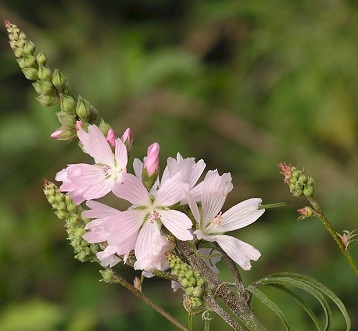
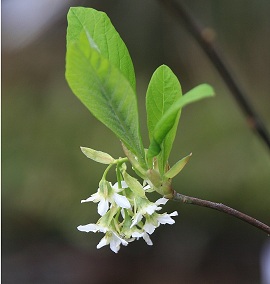
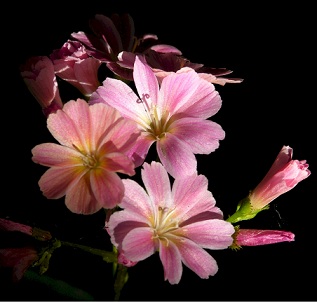
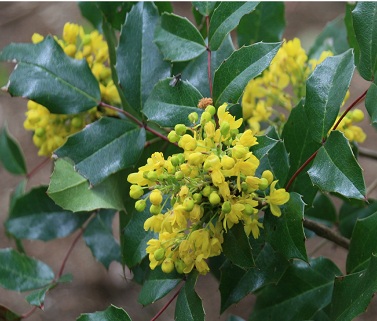
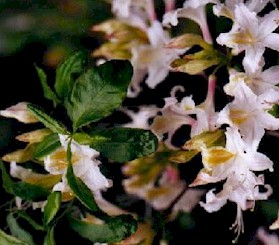 |
|
From Jennifer, June 12, 2009
Gadding about on the web a while back, I ran
into a wonderful article about gardeners who are embracing their 'wild side' by
using plants native to the northwest in lieu of hybrids or aliens or exotics or
(gasp!) invasives.
As a long time native plant lover, it makes my heart feel
good to learn of others with similar feelings for the plants that grow naturally
here in the Pacific northwest. We are growing in number, we native aficionados,
and that is a good thing.
It is particularly heartening to read about someone who
ripped out the English ivy in her garden and, months after removal of this
invasive thug discovered a Maiden Hair Fern growing demurely in the cleansed
space. It is as though nature placed this beautiful plant there as a thank-you
gift.
Gardening with native plants is a very rewarding thing to
do. Oh, it's ever so much easier on the gardener. The work of keeping a garden
lovely is greatly diminished. Once the plants are established the maintenance is
pared down to an occasional watering when weather is unusually dry or adding a
little mulch where needed. What is left to do at that point is simply admiring
nature's handiwork, cutting a few flowers or leaves to enjoy indoors or
harvesting fragrant elements to use as potpourri.
Once including natives in the landscape is actually tried,
it most often becomes the norm rather than the rarity. And there are other
benefits--aside from making less work, gardening the natural way is cheaper,
birds will eat the bad bugs, butterflies will flitter about to amuse and the
very air is more healthful to breathe because the use of chemical fertilizers
and bug sprays will be superfluous.
The article referred to above is Not
in my Backyard by Stacey Wilson,
subtitled "Invasive plants are out, native plants are in, and Portland gardeners
are embracing their wild side." Read the entire article on Portland Monthly's
website at
www.portlandmonthlymag.com/issues/archives/articles/1008-features-backyard/1/
Extra
Rewards for Native Gardens
There are programs dedicated to encouraging gardeners to go
native that provide some incentives beyond improving the livability of the
landscape. The best known is the Backyard Habitat Certification Program, a
collaboration by the National Audubon Society and Three Rivers Land Conservancy
which offers monetary rewards and other perks. A friend of mine named Linda who
lives here in Salem had her yard certified some years ago. It is an honor and a
wonderful example of cherishing the earth. Read more info on this program: www.audubonportland.org/issues/protect-wildlife
|

Above, Ivy growth phase
Photo credit: Uwe H Friese
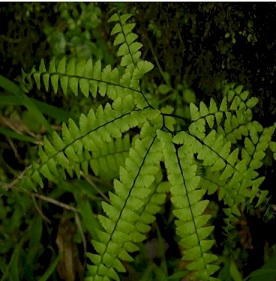
Below, Ivy seed phase
Photo credit: Petr Filippov
 |
|
From Jennifer, June 6, 2009
Was that ever a storm! Rain, hail, heavy
winds, tornadoes and flooding all in one 24 hour period. Mother nature surely
did pitch a fit. Now, two days later we have a bright sunny day.
Hope none of you lost trees in all that commotion. There
were many still on the ground yesterday blocking roads and smashing other plants
in their wake.
If you do have damage, we urge you to take care of it as
soon as possible. Spring is a strong growing period. Tree branches left on the
ground for even a short time may be preventing appropriate growth of any plants
the branches are lying on. Do check your garden and landscape for debris.
Another problem aggravated by items the wind has deposited
is the ever-present slugfest. Those slimy things are drawn to impromptu shelter
and though they don't seem to be light on their 'feet,' they can set up
housekeeping quicker than one might expect.
Wildlife during this storm were a bit verklempt. I was
driving north from Corvallis, just barely ahead of the wind and beating rain.
All the cows in every pasture I passed were lying down, giving the impression
they intended to stay right there until it all passed. There was one single bird
trying to fly into the wind and the wind was winning the race. The poor little
thing was barely staying even when a huge gust buffeted it directly sideways and
it landed into a clump of bushes. I was extremely concerned before the wind
deposited him into that natural safety spot.
Then yesterday after it had all settled down, I saw a
turkey vulture standing at the end of a driveway just barely off the road. He was
obviously stunned and shook his head a few times as if to clear his brain. I
don't know his story but I must say it surely takes another turkey vulture to
appreciate the looks of that species. In my opinion the only being on earth
uglier than a turkey vulture is a hyena. They probably think humans are no great shakes
in the beauty department either.
|
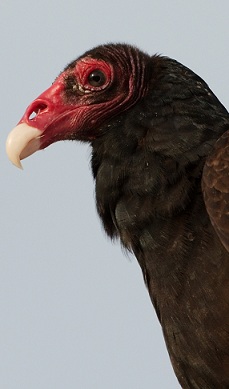
Close up and
personal
Photo credit:
Don Cathartes
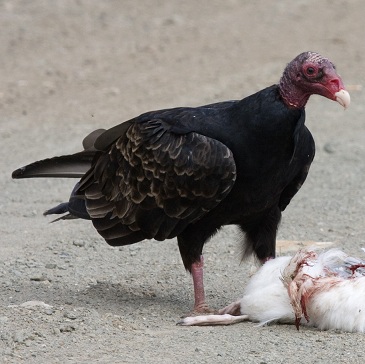
Mid-road dining
Photo credit:
Kevin Cole |
|
From Jennifer, May 13, 2009
This morning I saw
Common Camas (Camassia quamash)
beginning to bloom, many Wild Flag (Iris tenax) along the waysides, some of the
many types of Spirea, Cow Parsnip (Heracleum lanatum), a few varieties of Checkermallow, several
Pacific Dogwood (Cornus nuttallii) and the creamy white
flowers of Madrone (Arbutus menziesii).
I was delighted to notice a small herd of goats browsing in
an old orchard of Garry Oak (Quercus garryana var. garryana). Most were content
to nibble the plants close to the ground but one had placed his fore hooves high
against the trunk of an oak and was making a fine breakfast of fresh growth.
It is such a treat to be able to observe such a rich
variety of plants native to the northwest on a simple trip to work. It seems
each day nature is so overjoyed with her handiwork she gives these surprising and
awesome glimpses of what she is about. The lady has her hands full but still
finds time to share, to make us laugh, to show us something beautiful right in
our own backyards.
I find it to be a never-ending display of bark and leaf and
bloom as I walk among the gardens here at the nursery. Wildlife abounds. Birds,
butterflies, possum and raccoon, very often a deer ventures forth among the
shrubs taking a taste of this, a snip of that. Rarely do these visitors cause
much harm. After all, what are a few leaves or sweet tasting flowers when there
are so many more in the garden.
I am especially interested in the blooming trees and shrubs
that follow the bloom with fruit for the table. So many and such varied flavors!
Everyone knows of my love for huckleberries but did you know the
Oregon Grapes (Mahonias)
are also among the gourmet quality fruit native to the northwestern U.S.?
Serviceberry (Amelanchier alnifolia) is beyond description in words with its
rich sweet berries. Even the little violets are at home sprinkled in a fresh
green salad.
Walk in your gardens. Stoop down to smell the perennials.
Clasp branches of shrubs and trees to bring close and breathe deeply the aromas
they share.
|
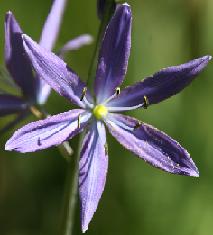
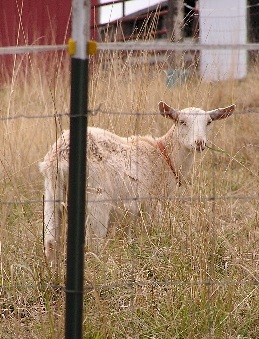
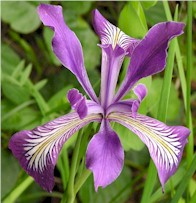 |
|
From Diana, March 6, 2009
The
Tale of the Traveling Plants
It was a day much like any other. The plants were all
growing in their pots, the birds were singing and the squirrels were playing
among the oaks. I had just made myself a nice cup of tea and sat me down to
enjoy this peaceful garden I do so love, when the phone rang.
"Wally Hansen's Native Plant Nursery," says I.
"Oh, I'm so glad you're there. I need to get some native
plants for a friend to take home. He wants Oregon Ash, Big Tooth Maple, Port
Orford Cedar, maybe some others. He wants to take them with him when he returns
to Budapest, Hungary. Can you help? I know this is a lot to ask but he needs
some excellent, healthy specimens that will make the trip and thrive."
"Hmmm, I think we can provide just what he needs. How soon
is he leaving?"
"Right away. I told him it would be a miracle to get these
plants in time and it's very hard to find them at this time of year."
To which I replied, "Well, my dear, we've been known to
pull off a few miracles. Rest assured we will have the plants for your friend
ready in the blink of an eye (figuratively speaking)."
Our caller expressed the greatest thanks for fulfilling her
friend's wishes while I scribbled a note for Victor who immediately set forth to
fetch the plants.
We carefully washed every speck of dirt from their bare
stems and naked roots, sealed them in plastic bags for the journey and by the
time she reached the nursery we were ready with the plants.
Later we got an email from her saying the plants had
arrived in Budapest and were at that moment enjoying the fresh air on her
friend's Hungarian terrace still bagged!
I'm again pausing from my planting labors, mug of java in
hand, smiling once more and remembering the amazed customer for whom we
delivered a little miracle. It's all in a day's work.
|
 |
|
h
2008
h |
From Jennifer, August 16, 2008
Few will debate the fact that the last several days here in the Willamette
Valley have been HOT. The favored temperature by most folks ranges from 70 to 80
in the daytime and around 60 at night.
This past week has exceeded the preferred climate by several degrees and just
about everyone is searching for cool spots. I am one of the lucky ones with
large trees shading my house on the south and west sides. I don't have air
conditioning and really don't need it. I can go outdoors and relax in the shade
of a huge maple or one of the other members of my personal forest.
But if your trees have not reached the size to provide shade, there is
probably a nice park close by or a spot out in the country with some big trees
that wouldn't mind shading you while you picnic or just relax.
While you are taking a siesta or filling up on sandwiches and salad, do a
little daydreaming about a tree or two that would add value to your home as well
as providing a natural cooling element. Of course, the best trees are natives
and we have a grand selection of shade trees that are beautiful. Many have
flowers or fruit or nuts, many keep their leaves all year or have vibrant fall
color.
Here are a few of our favorite trees for shade:
Dawn Redwood (Metasequoia glyptostroboides) grows fast when young, has bright
green leaves, soft to the tough, which turn a beautiful gold color before
falling. Gives dappled shade.
Canyon Live Oak (Quercus chrysolepis) is an evergreen oak that likes dry,
rocky ground and is very drought resistant. can ready 30-80 feet with a wide,
majestic crown. Very hard wood once used for wagon wheels.
Rocky Mountain Sugar Maple (Acer grandidentatum) requires minimal care and
usually reaches 20-30 feet at maturity and almost as wide as it is tall. Yellow,
orange and red fall leaf color. Not particular about environment, grows in low
desert, along streams and high mountain regions.
Western Crabapple (Malus fusca) grows moderately fast to around 40 feet.
Branches have sharp spurs, not a good tree for climbing. White clustered
flowers, very fragrant, tart fruits make excellent jams if the birds don't get
them all.
Buckeye (Aesculus californica) is a chestnut family tree that grows fast to
around 20 feet with well-rounded crown. The broad leaves offer superior shade
and the beautiful flower spikes in spring have great fragrance and are loved by
hummingbirds. The giant chestnut seeds will be carried away by squirrels and
chipmunks.
|
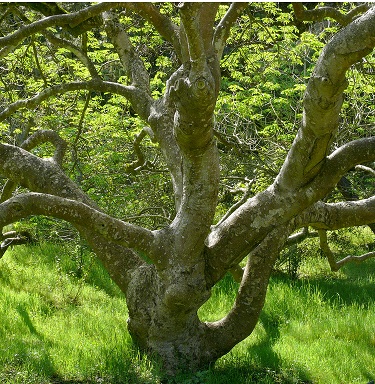
Photo credit: James Gaither

Photo credit: Stan Shebs
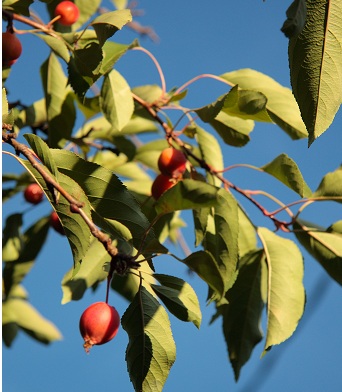
Photo credit: A. Gude
|
|
From Jennifer,
July 19, 2008
Recently I found myself tasked with
decorating for a celebration of someone's life. The gentleman we were
remembering was an outdoorsman who loved hunting and fishing and camping. I
elected to use living specimens of plants native to the northwest. It was a
natural choice for me--after all I am known as "The Native Plant Lady." *
We covered the plastic nursery pots with pale green plastic
bags to dress them up a little. We set some on the tables of memorabilia, some
were at the refreshment table and we placed others on and around a table at the
entrance. At right are some snapshots of the final outcome.
Top: A
fern stands beside the United States flag that was given to the family on
his death. Beside the table are a
Noble Fir (Abies procera) and a
Sword Fern
(Polystichum munitum). Just outside the door (not shown) was a Pacific
Rhodie (Rhododendron macrophyllum).
Second: A
small pine props up a family photo with another
Sword Fern (Polystichum
munitum) beside the table.
Third: The
fern on the table affords a spot of greenery and the lush foliage of a young
Western Hazelnut (Corylus cornuta var. californica) stands on the floor.
Fourth: The
far corner of the memorabilia table has two small conifers snuggled with
dark green felt making a 'hill' behind the fishing pole, the old cowboy hat
and other treasured items.
Consider using living native plants as decorations for
special events.
Placing the nursery pots into larger decorative pots to fit
the theme will display well. If you prefer, you could cover the pots with
plastic and wrap a suitable fabric around them. Anything from natural burlap to
brocade satin tied with a bow dresses up those plain pots quite nicely.
*The Native Plant Lady
Diana dubbed me "The Native Plant Lady" because of my
Native American heritage and my passion for northwest native plants. It's a
natural fit and a title I'm proud to wear.
Each day I learn more about these beautiful native plants
we are so fortunate to live among. And it seems that each discovery brings
another blending of the qualities of the plants and the ways Original People
used them.
|
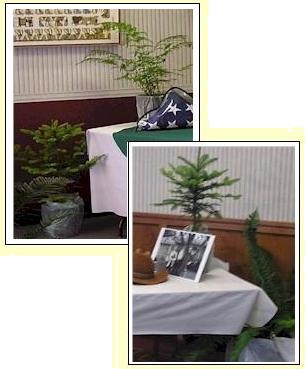
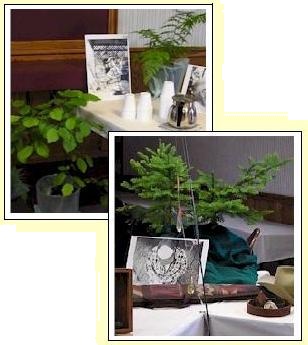
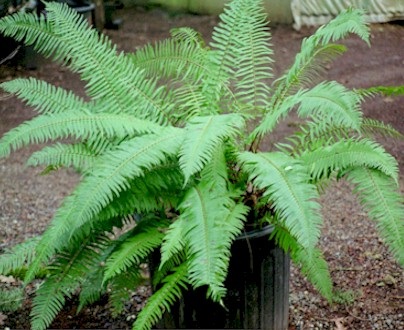
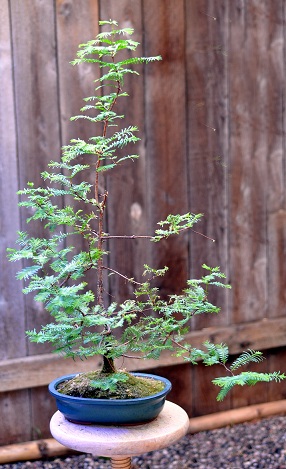 |
|
From Jennifer,
June 15, 2008
So many native plants, so little time! I
calculated the number of northwest native plants I'd like to get to know well,
up close and personal. There are about 300 different plants I put in this
category. If I begin right now and study one plant a month total (that's one
week for each season because very few plants are identical from spring to summer
to fall and then to winter), it will take me over 25 years to complete this
study. That means I will have filled this thirst for native plant knowledge by
the year 2035 (including time off for good behavior).
That's not so long. I will be a mere 92 years old then, in
the autumn of my life. I can use the next 10 years or so writing botanical
books! Well, time's a-wasting--let's get started.
This beautiful blue-purple
perennial seems as good a place to begin as any.
Trollius-Leaf Larkspur,
Delphinium trollifolium
Look at those exquisite little flowers! Vibrantly
jewel-toned, each one on a separate stem from the main one giving the plant an
airy, open countenance. They are held to the plant in such a way that they
appear ready to take flight at any moment.
|
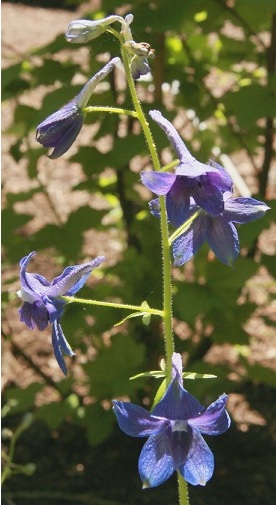 |
|
From Jennifer, May 3, 2008
This
morning was almost more exciting than my poor brain could handle. I guess it was
the sunshine that started it all. And it wasn't just me--everybody was smiling
and swinging their arms as they walked, observing the birds and flowers and that
big blue sky.
The first thing that happened was a little mother duck and
about 8 or 10 tiny ducklings chose the very moment I happened to drive down S.
River Road to cross that busy street. They were all lined up and the mum had
obviously told them to walk smartly along. They were so cute! I immediately
turned around and parked, peering through all the bushes to see where they went.
I had in mind to snap their photo. Well, I couldn't find them and it was just as
well since I had forgotten my camera.
I resumed my commute and it wasn't long before I spied the
first native
iris of the year growing about a
foot away from the first sighting of Camas.
No camera, so I drank in their beauty for a moment before I continued on my way.
Enjoying the
Serviceberry blooms (Amelanchier
alnifolia), the Dogwood trees (Cornus
nuttallii) and the last of the
Oregon Grape flowers (Mahonia),
the Willamette Valley seemed on this edenic morning to be one of the most
beautiful places on Earth.
The last surprise before I reached my destination was a
large Blue Heron standing, not out in the middle of a field as I usually see
them, but quite close to the fence that surrounded a pasture.
So many photo ops, and no camera! I hope you native plant
lovers are catching these northwest original trees, shrubs and perennials as
they put on their glorious annual show unaided by any earthly gardener. And I
hope you get to see some baby ducks and a blue heron!
|
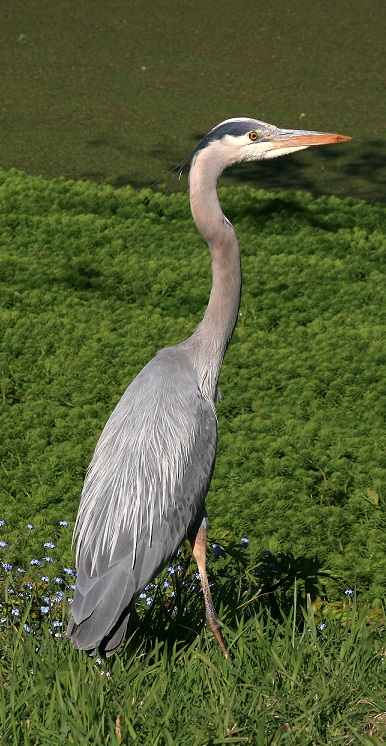
Great Blue Heron in
Golden Gate Park
Photo by Brocken
Inaglory
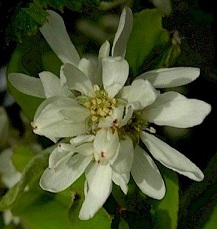 |
|
From Jennifer, April 17, 2008
What glorious weather we've had lately!
Sunny skies and mild temperatures beckon us to come out and play. I bought a new
pair of gardening gloves today and picked up a load of cedar chips to go in my
doggie's outdoor room. Right now my grandson and his friend are freshening up
the back yard. I'm headed out to the front yard to pull weeds. The dandies (Taraxacum officinale) have made
themselves quite at home along with a goodly portion of shoot-your-eye-outs (I
don't know the botanical name of these but they go to seed quickly and when you
touch them the seeds fling themselves far and fast).
I have some
Wood's Roses (Rosa woodsii), a beautiful
Lady
Fern (Athyrium filix-femina var. cyclosorum) and some
Coastal Strawberries (Fragaria
chiloensis) to plant after I get rid of the weeds. My favorite plant awaiting
it's home is a Red Elderberry (Sambucus racemosa var. arborescens). It is going
to be a part of the centerpiece of my front yard. I haven't decided what it's
companions will be yet. (Maybe a Red-Flowering Currant?) In some ways, designing
a garden is like picking your own holiday presents!
|
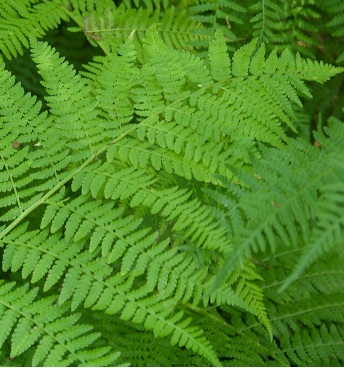 |
|
From Jennifer, April 4, 2008
Sunshine, snow, hail and rain. March came in
like a lion, pranced about like the gypsy queen she is and left in a huff.
Spring is so much fun!
I've no complaints though. In fact, it's rather exciting.
Dressing in layers for day trips is almost mandatory unless one carries an
entire wardrobe along. It's no wonder nature is sometimes unpredictable
(sometimes?).
So far, April has been a sunny delight but I heard the
weatherman announcing rain will be coming tomorrow. Good--it will give those
Sword Ferns I planted an appropriate settling in. Fresh plantings always enjoy a
good soaking.
|
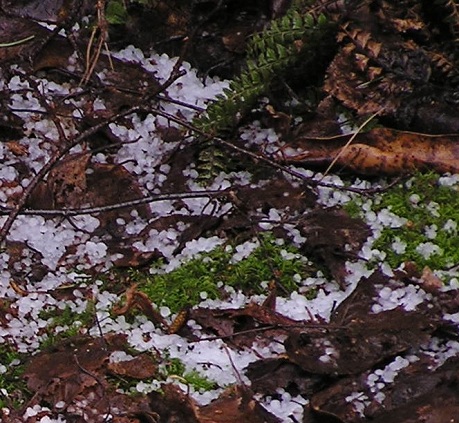 |
|
From Jennifer, March 26, 2008
Between the lambs and the spring flowers,
it's a wonder I ever get anywhere!
Seems like every other pasture has a thriving population of
momma sheep and baby lambs. Some are all white (well, sort of), some are white
with black faces, some are all black, and then some are spotted. Well, I never!
So, of course it was time to pull over and take their picture.
It wasn't very far after that when I went off on my
favorite gravel road and there were scads of
Spring Queens just blooming their
little hearts out. Not to be outdone, the
Fawn Lilies (also known in some
quarters as Lamb's Ears) were in abundance.
|
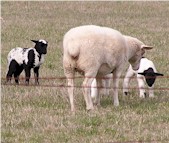 |
From Jennifer, January 23, 2008
Winter can be a difficult time for gardening if you're getting along in years,
especially when arthritis has moved into your aging frame. The cold seems to
seep clear into your bones. Damp and windy days seem made for staying indoors
even though you know a bit of fresh air and exercise, however short lived, will
keep those knees and other joints lubricated. Helen Hayes said "If you rest, you
rust."
So I pull on my sweatshirt and gloves and resolutely step outside. It's not
raining today, no need for an umbrella. I've no destination in particular except
to see what nature has done with herself since I last ventured forth outside of
the commute to work or running errands. It's the weekend and my time is my own.
The maple tree is still bare. It's a nice shape and the bark is interesting.
A squirrel is scampering around and runs to the other side of the maple, peeping
around it's trunk as I walk by. I pretend I don't see him so he'll not know his
cover is blown. The air is sharp on this chilly afternoon and I get a whiff of
someone's fireplace. The doug firs are very fragrant. They smell like being out
in the woods.
Around the block and I'm ready to come back indoors. I've done my duty, moved
my limbs, felt the winter sun on my face and can now enjoy my afternoon tea with
clear conscience.
It won't be long, just 4 weeks, until the winter wrens and song sparrows will start to sing. I learned this from a naturalist writer who sends me an email each
week called "This Week in the Woods." His name is Rob Sandelin and it was he who
inspired me to get off my duff and go outside today. He works with the Monroe
School District's Environmental Science School in Monroe, Washington. He is the
author of A Field Guide to the Cascades and Olympics. You can see his columns
and other writings at http://share3.esd105.wednet.edu:80/rsandelin/NWnature/NWNature.htm.
If you subscribe to his mailing list, he'll send you his weekly column.
|
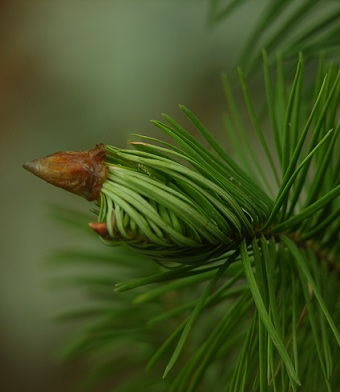
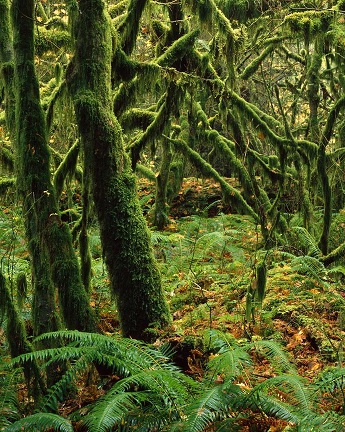 |
|
h
2007
h |
|
From Jennifer,
December 2, 2007
Brrrr!
It's chilly here in Oregon's Willamette Valley. Promises (threats??) of snow are
the subject of weather forecasts. Personally, I enjoy a good snowstorm as long
as I don't have to go outside. There is nothing quite so cozy as sitting beside
a blazing fireplace sipping tea and watching the snowflakes drift down to
blanket the earth.
Oh, it's not even awfully bad to bundle up and brave the
elements as long as one is prepared. For some reason, when we get a nice
covering of snow we all seem to turn into children. We may be slipping and
sliding around in our boots and mittens but we're laughing all the same.
If we do get snow, bundle yourself up and brave the world
of white. Take a walking stick of some sort if you're on foot so you can balance
better (also fun to poke iced-over puddles with). If you're driving, slow and
easy are the words to live by. Do everything in slow motion and allow for
skidding if it should occur. By all means put a blanket in your vehicle and some
water and snacks just in case. Emulate those Boy Scouts--be prepared.
|
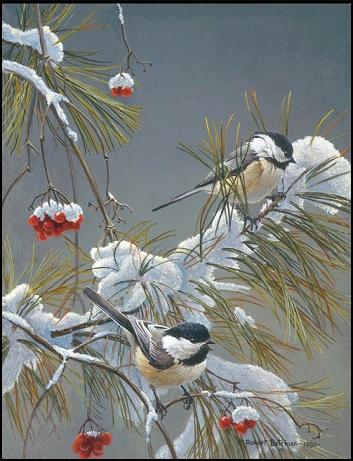
Robert Bateman's
Winter Song Chickadees |
|
From Jennifer, November 20, 2007
The Thanksgivings
Translated by Harriet Maxwell Converse from a traditional Iroquois prayer
We who are here present thank the Great Spirit that we are
here to praise Him.
We thank Him that He has created men and women, and ordered
that these beings shall always be living to multiply the earth.
We thank Him for making the earth and giving these beings
its products to live on.
We thank Him for the water that comes out of the earth and
runs for our lands.
We thank Him for all the animals on the earth.
We thank Him for certain timbers that grow and have fluids
coming from them for us all.
We thank Him for the branches of the trees that grow
shadows for our shelter.
We thank Him for the beings that come from the west, the
thunder and lightning that water the earth.
We thank Him for the light which we call our oldest
brother, the sun that works for our good.
We thank Him for all the fruits that grow on the trees and
vines.
We thank Him for his goodness in making the forests, and
thank all its trees.
We thank Him for the darkness that gives us rest, and for
the kind Being of the darkness that gives us light, the moon.
We thank Him for the bright spots in the skies that give us
signs, the stars.
We give Him thanks for our supporters, who had charge of
our harvests.
We give thanks that the voice of the Great Spirit can still
be heard through the words of Ga-ne-o-di-o.
We thank the Great Spirit that we have the privilege of
this pleasant occasion.
We give thanks for the persons who can sing the Great
Spirit's music, and hope they will be privileged to continue in his faith.
We thank the Great Spirit for all the persons who perform
the ceremonies on this occasion.
|


Harriet Maxwell, 1836-1903 within a family fascinated by Native
cultures. Both her grandfather and her father were Indian traders adopted by the
Seneca Nation; her grandfather, Guy Maxwell, earned the respected name "Ta-se-wa-ya-ee"
("Honest Trader").
In 1881, Harriet and husband Frank Converse met Ely and Minnie
Parker. Ely was a chief in the Iroquois Nation. He and Harriet researched,
collected many cultural artifacts, most now in collections of the State Museum
at Albany. She was a political advocate for the Six Nations, and used her
writing skills and enthusiasm on their behalf.
The Seneca Nation adopted her into
the Snipe Clan, and named her "Gayaneshaoh." In September of 1891, she became
the first white woman condoled as a Six Nations Chief. She was given
responsibility of welfare of her adopted people, and given a new name, "Gaiiwanoh,"
("The Watcher")
Her collection of essays entitled
Myths and Legends of the New York State Iroquois was published 5 years later,
edited by Ely Parker's grand-nephew, Arthur C. Parker.
Oregon's Public Broadcasting
hosted a program titled "Warrier in Two Worlds" which chronicled Ely Parker's
life, beginning with the startlingly prophetic dream his mother had five months
before he was born.

See the whole story:
www.pbs.org/warrior/indexf.html |
From Jennifer, October 21, 2007
Brrrrr! The wind! The rain! Mother Nature is conducting her annual fall
cleaning, sweeping away the debris, mulching the plants and preparing the earth
for winter by giving the soil a good soak.
It is not too late to plant. In fact, digging those holes is easier now that
the ground is softened up. So put on your waterproof and your gardening clogs or
Wellies and dig in!
If it's trees you're planting, the question comes of whether or not to stake
the tree. Here's what Oregon State University's Extension Service has to say
about it:
Staking and Wind Protection: Generally, you don't need to stake trees. Young
trees standing alone with their tops free to move will develop stronger, more
resilient trunks than tightly staked trees. However, too much wind can bend
young trees and disturb the root ball, damaging roots and stressing the new
tree. Staking helps trees that are top-heavy and would lean without additional
support. Staking also helps protect trees from vandalism and mechanical damage.
In areas of Oregon exposed to high winds, such as the coastline (and right
now, today, the entire Willamette Valley!--Wally), trees may need additional
protection. Use temporary wind barriers made of plastic or cloth, but remove
them within 1 year once the tree has developed a stronger root system.
To properly stake a tree, you need two wooden or metal posts. Drive them into
the sides of the excavated planting hole before you backfill to prevent driving
them through the root ball. Secure the tree to the stakes with broad straps or
hose; don't use wire because it will girdle the bark of the tree. Guying and
staking the tree so it is secure from blowing over, but allow the trunk to move
up to 2 inches in any direction.
If staking doesn't allow some movement of the tree's trunk, the tree will not
allocate any growth (wood) to the main stem and it will be unstable when you
remove the stakes and guying. Remember to remove the stake and guying materials
within a year.
Autumn Song
by Katherine Mansfield
Now's the time when children's noses
All become as red as roses
And the
colour of their faces
Makes me think of orchard places
Where the juicy apples
grow,
And tomatoes in a row.
And to-day the hardened sinner
Never could be late for dinner,
But will jump
up to the table
Just as soon as he is able,
Ask for three times hot roast
mutton--
Oh! the shocking little glutton.
Come then, find your ball and racket,
Pop into your winter jacket,
With the
lovely bear-skin lining.
While the sun is brightly shining,
Let us run and play
together
And just love the autumn weather.
|
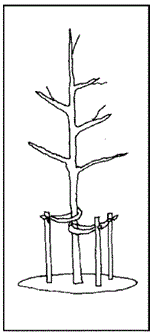


The right way to stake most trees (top), the
wrong way to stake any tree (center), and the right way to stake a skinny tree
that cannot stand on its own (bottom).
|
From Jennifer, October 1, 2007
What do gardeners do when the rain is falling and the wind is blowing? Plan!
Focus on wildlife in the garden. Find tips for keeping those out that you don't
want and attracting the ones you like. Decide which wildlife fits into which
category is a purely personal decision. You may like to see deer in your yard in
the morning or you may wish they'd go somewhere else. You might love watching
birds and want more of them. Or you may think they are a big nuisance.
Whichever way your feelings lie, find ideas you may not have considered
before. Gather ideas from various sources, see things other gardeners have tried
and swear by.
Personally, I'm a live and let live gardener. Whatever chooses to visit my
yard is welcome. Except for that raccoon, that is. Him I took great exception
to. He drug down the liner to my pond and all the fish died. He drug my water
plants all over the yard (those he didn't eat). He made it clear he had decided
to take over my water garden and I objected. I'll tell you this story another
time. For now, let's just say that this bandit met his match.
|
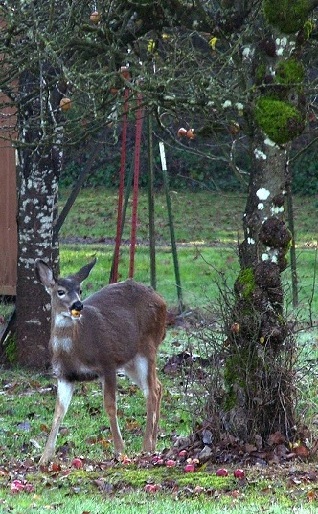 |
From Jennifer, September 12, 2007
Though everyone in the U.S. remembers what they were doing when the Twin Towers
came down on September 11, for once we forego our personal side--we focus on
what really happened and what it meant. And mostly, I think, we remember what
was lost.
Nothing can undo what was done that day. But we can pay our tributes to the
brave people who gave everything they had to help. Some gave their time, some
gave money, and some gave their all.
Now in New York there is a memorial of those who died on that dreadful day.
Visitors there are profoundly moved as they pause to reflect or to pray.
When we experience something in our lives that we want to remember, whether
in joy or sadness, it is often helpful to set aside a place for resting. Many
have found planting a tree or shrub or special flower to be a comfort. I think
the connection between nature and man is simple, basic, and pure--no frills
attached-- just living things growing from the earth on which we stand.
Memory Garden Plants
Should you decide to plant your own living memorial, consider the Big Tree.
One of the oldest living trees is a member of the Cupressaceae family. the
genus Sequoia. This is the Coast Redwood (Sequoia sempervirens). It's brothers
in the subfamily Sequoioideae are the
Giant Sequoia (Sequoiadendron giganteum)
and the Dawn Redwood (Metasequoia glyptostroboides).
Giant Sequoias are the largest trees known to man. Larger than a dinosaur,
bigger than a whale, as tall as a football field is long, these incredibly huge
trees are now native to the coastal regions of Oregon and northern California.
The largest living Giant Sequoia is the General Sherman Tree in the Giant Forest
area of the Sequoia National Park in California. Standing at 274.9' (83.8
meters) tall, and 102.6' (31.3 meters) in circumference at its base, the
General's wood is roughly equivalent to 180 miles of 2x4's. Were this a
harvestable lumber tree, it's wood is enough to build over 40 houses, each with
5 rooms. Other trees in the world are taller: the tallest tree in the world is
the Coast Redwood, which averages between 300' - 350' in height. Near Oaxaca,
Mexico is a cypress which has a greater circumference, 162'. But in sheer mass,
the General has no equal, and earns this tree the title of the World's Largest
Living Thing.
Other plants favored for memory gardens include:
Paper Birch (Betula papyrifera), often planted in a group of 3 or 5.
Wild Roses (the
Little Wild Rose--Rosa gymnocarpa,
Nootka Rose--Rosa nutkana,
Clustered Rose--Rosa pisocarpa, or
Wood's Rose--Rosa woodsii)
Western or Sessile Trillium (t. ovatum or
t. parviflorum) which come up every
spring and bloom at Easter time.
Or, to remember a special person, select a plant they particularly loved.
Include a place to sit in your memory garden, perhaps a wind chime or a nice
rock.
|

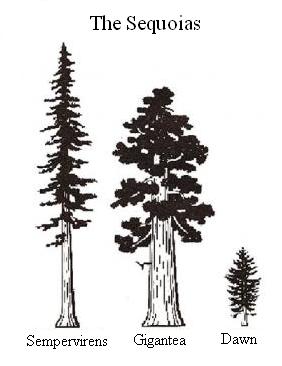

Giant Sequoia |
From Jennifer, September 3, 2007
Caveat Emptor - "Let the Buyer Beware!" I once received a beautiful autumn
coffee-table arrangement of flowers from a florist that had twined all within it
strands of Atropa belladonna (Deadly Nightshade).
Since I was familiar with this plant I knew it was highly poisonous and those
intriguing fruits would be all too attractive to my 2 year old grandson.
I called the florist and asked if he knew what he had put in the arrangement.
He did, but he did not know it was poison! Needless to say, he knows better now
and I sincerely hope he is doing better.
If you don't know this plant, here are photos of the flower and fruit.
Beautiful, no?
|
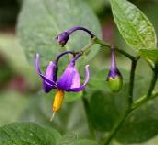
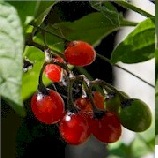 |
|
From Jennifer, April 1, 2007
Spring is truly here in the northwest. Birds are singing
and the sun shines almost every day. The spring rain blesses the garden with
gentle drops, quenching the thirst of plants emerging from winter slumber. Gusts
of wind sweep clean the bits of debris left from winter frost. My heart is
gladdened by these signs of life which give fresh hope--it truly does spring
eternal.
Nature is filled with such complex roles played by flora
and fauna. The young leaves tempt slugs and bugs while the birds watch from the
branches above, waiting for just the right tasty morsel to crawl into view. Cats
keep their eyes out for the unwary bird. The survival of the fittest plays out
again and again, yet some live to see tomorrow. Always, there will be tomorrow.
And the garden awaits.
Enjoy the spring and each fresh new day, go into your
garden when you feel blue or tired or stressed. There will be the regeneration
of spirit that keeps us going day after day after wonderful day.
|
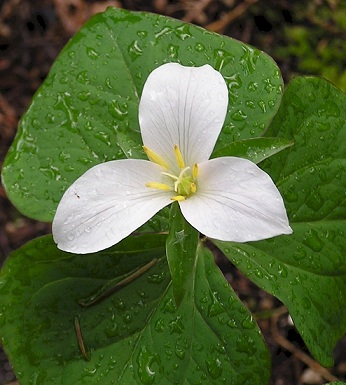 |
|
h
2006
h |
From Jennifer, December 24, 2006
A great man, Martin Luther King, Jr., spoke the following words which are very
appropriate at this time of year.
"Everybody can be great. Because anybody can serve. You don't have to have a
college degree to serve. You don't have to make your subject and your verb agree
to serve.... You don't have to know the second theory of thermodynamics in
physics to serve. You only need a heart full of grace. A soul generated by love."
--Martin Luther King, Jr.
It is easy to get caught up in the hustle-bustle
buying and wrapping and stringing of lights, the rush to make the perfect
holiday.
But take a moment to remember what we're here for
and how we can do the best good with our lives. For that is the true spirit of
this time.
|

This work is in the public
domain in the United
States because
it is a
work of the United States
Federal Government under
the terms of 17 U.S.C.
§ 105. |
From Jennifer, November
21, 2006
How fortunate we are to live in these times when
there are so many tools and machines to help us do our work, movies and concerts
and zoos to amuse us. We have grocery stores and clothing stores and furniture
stores, stores for just about anything we could imagine--we need not craft a
chair or grow our own fruit. We have medicines and doctors to care for our
ills--cures for diseases that were not even identified 100 years ago. We have
police officers and firefighters who come to our aid when we call.
I fear sometimes we are too "advanced." I fear we
have forgotten the joy of sewing a shirt or knitting sox. The spirited feeling
we get from singing or twirling around just for the sheer nonsense of it.
At this holiday dedicated to giving thanks, let us
be aware of the amazing world in which we live. Let us not be so "important" we
forget how truly blessed we are.
The one single activity that centers me and brings
me back to earth when my self-importance has begun to soar is to stand beneath a
big tree so that I can remember how big I really am.
My favorite tree for this activity is the Giant
Sequoia. How fitting to stand in the company of a tree named for a man of
questionable ancestry, a man whose physical injuries did not stop his task of
forming symbols so that the Cherokee language could be written. A man small in
stature for whom the tallest tree in the world is named.
"Man sometimes thinks he's been
elevated to be the controller, the ruler. But he's not. He's only a part of the
whole. Man's job is not to exploit but to oversee, to be a steward. Man has
responsibility, not power."
"I do not see a delegation for the four-footed. I see no seat for the eagles. We
forget and we consider ourselves superior. But we are after all a mere part of
the Creation. And we must consider to understand where we are. And we stand
somewhere between the mountain and the Ant. Somewhere and only there as part and
parcel of the Creation."
Oren Lyons, Onondaga
(From an address to the
Non-Governmental Organizations of the United Nations, Geneva, Switzerland, 1977)
|

ᏎᏉᏯ Se-quo-ya
Sequoyah, sculpted bronze
figure by Lee Lawrie in
1939. Door detail,
east entrance,
Library of Congress
John Adams Building,
Washington, D.C. |
From Jennifer,
November 11, 2006
Ok, enough is enough. Rain, rain go away! Even an
eternal Pollyanna like me can get their fill of a good thing. Rain is good,
don't get me wrong. But there are limits to one's cheerful acceptance of water
hurling itself out of the sky and I think I've reached it for me. It's time to
pull out all the stops and do some gardening attitude adjustment.
I have a plan, one that cannot fail. Using the
very best gloom-fighters at my disposal I shall carry my brightest umbrella and
follow this plan to find some joy in the rain:
- Starting tomorrow, I am going to wear
something yellow every day. (Yellow = sunshine.)
- I will drink only herbal teas with flowers in
their names, like rose hip and elderberry and Red Osier Dogwood.
- I will dedicate each day to a plant (a
northwest native plant, of course).
- As the rain comes down I will think of how
thankful that plant is to have all the water he or she could possibly want.
- I will remember how dry it was a few months
ago and how beautiful that plant will be when springtime comes.
- And every evening I will curl up with my
favorite lap robe and read my NW Native Plant Journals. We've been
publishing them since October, 2003 so there'll be plenty to read.
And sometimes, on especially dreary days, I'll
study my Garden Planner and the catalog I printed out--the color version--and
plan my next garden.
OK, the rain may stay. And when the sun peeps
through, there will be a rainbow to remind me of why there is rain.
The Rainy Day
by Henry Wadsworth Longfellow
The day is cold, and dark, and
dreary;
It rains, and the wind is never weary;
The vine still clings to the moldering wall,
But at every gust the dead leaves fall,
And the day is dark and dreary.
My life is cold, and dark, and
dreary;
It rains, and the wind is never weary;
My thoughts still cling to the moldering Past,
But the hopes of youth fall thick in the blast
And the days are dark and dreary.
Be still, sad heart! and cease
repining;
Behind the clouds is the sun still shining;
Thy fate is the common fate of all,
Into each life some rain must fall,
Some days must be dark and dreary.
|
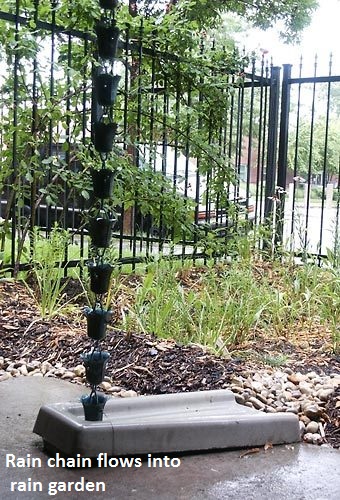
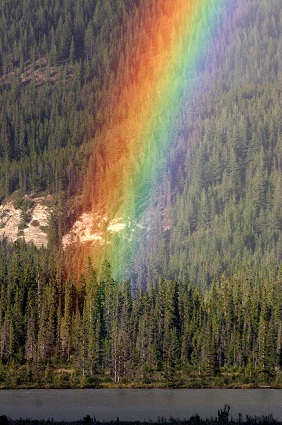
Photo
credit: Wing-Chi Poon
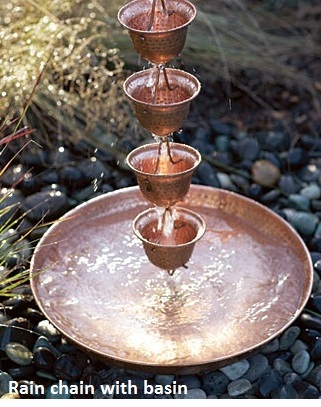 |
From Jennifer, October
21, 2006
Autumn in the northwest is such a joy! We've had a
very dry summer so every few days we get a spell of rain that lasts a day or
two. The world is dark and damp and the colors are gray. Then the rain clears up
and a whole bunch of trees and shrubs that were quite common looking before the
rain are suddenly vibrantly colored in the fall shades we love so well--red and
orange and gold and bronze and every single shade in between.
Today is one of those sunny days after a rain. The
plants in the nursery are simply glowing in their fall beauty. And to think:
they are on sale, even some of the very large trees are on sale!! All that
passionate autumn bliss is here at discounts to put a little smile on your
budget!
|
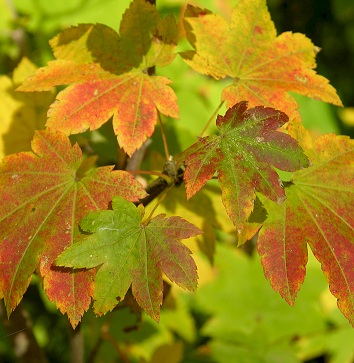 |
|
From Jennifer, April 10,
2006
So many flowers! Suddenly, it seems, the Willamette Valley
is all a-bloom. Everywhere one looks there are
Fawn Lilies (Erythronium oreganum)
and
Trillium (t. ovatum and t.
parviflorum) and
maples (Acer) and
Madrone (Arbutus menziesii).
Such a wealth of flowers in our little corner of the world!
The same spring fever that stimulates these blossoms
quickens the heart of every gardener. The birds sing for joy when they see us
turning the earth for planting--they know worms and bugs will be their reward.
And for gardeners? Our reward is the earth itself and
the bounty of fruit and leaf and flower we can enjoy for years to come. Such a
simple thing but it so enriches our lives.
|
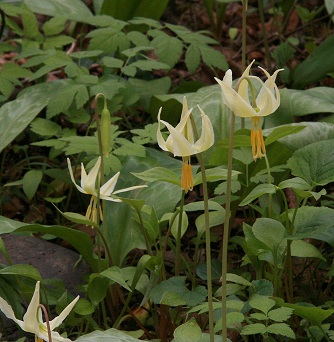 |
|
h
2005
h |
|
From Jennifer, December
30, 2005
An old custom of New Year's resolutions brings us
to thoughts of what we could have done better
or what we could have done at all.
Taking our pens, we write our resolution letter.
We promise to get thinner,
and young boys vow to be tall.
We'll save our money,
we'll mind our manners,
we'll never make folk feel small.
We hopefully swear to keep these rules,
we swear we'll recall!
But by mid-January, alas,
we've forgotten them all.
For the most part, New Year Resolutions are a
practice in futility that will make us feel woefully inadequate a month later
when we remember all those high-fallutin' but sincerely meant promises to
ourselves.
This year, I have but one resolution: To tend my
garden with love. All those other qualities and habits I wish to teach myself
will naturally find me if I but do this one thing. I will be a good steward to
the garden with which I have been blessed. My resolutions are made.
The following poem, A New Year's Gift, was sent to
Sir Simeon Steward by the poet, Robert Herrick (baptized 24 August 1591 –
buried 15 October 1674):
No news of navies burnt at
seas ;
No noise of late-spawn'd tittyries ;
No closet plot, or open vent,
That frights men with a parliament ;
No new device or late-found trick
To read by the stars the kingdom's sick ;
No gin to catch the state, or wring
The freeborn nostrils of the king,
We send to you ; but here a jolly
Verse, crown'd with ivy and with holly,
That tells of winter's tales and mirth,
That milkmaids make about the hearth,
Of Christmas sports, the wassail-bowl,
That tost up, after fox-i'-th'-hole ;
Of blind-man-buff, and of the care
That young men have to shoe the mare ;
Of twelve-tide cakes, of peas and beans,
Wherewith ye make those merry scenes,
Whenas ye choose your king and queen,
And cry out :
Hey, for our town green ;
Of ash-heaps, in the which ye use
Husbands and wives by streaks to choose ;
Of crackling laurel, which fore-sounds
A plenteous harvest to your grounds ;
Of these and such-like things for shift,
We send instead of New-Year's gift.
Read then, and when your faces shine
With buxom meat and cap'ring wine,
Remember us in cups full crown'd,
And let our city-health go round,
Quite through the young maids and the men,
To the ninth number, if not ten ;
Until the fired chestnuts leap
For joy to see the fruits ye reap
From the plump chalice and the cup,
That tempts till it be tossed up ;
Then as ye sit about your embers,
Call not to mind those fled Decembers,
But think on these that are t' appear
As daughters to the instant year :
Sit crown'd with rosebuds, and carouse
Till Liber Pater twirls the house
About your ears ; and lay upon
The year your cares that's fled and gone.
And let the russet swains the plough
And harrow hang up resting now ;
And to the bagpipe all address,
Till sleep takes place of weariness.
And thus, throughout, with Christmas plays
Frolic the full twelve holidays.
|

Peaceful Garden
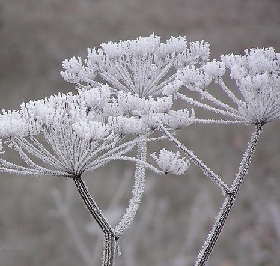
Cow
Parsnip
(Heracleum lanatum)
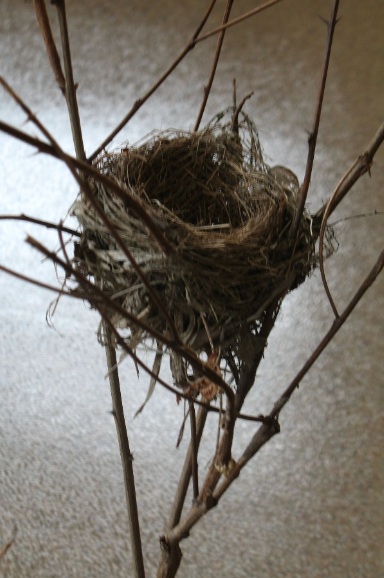
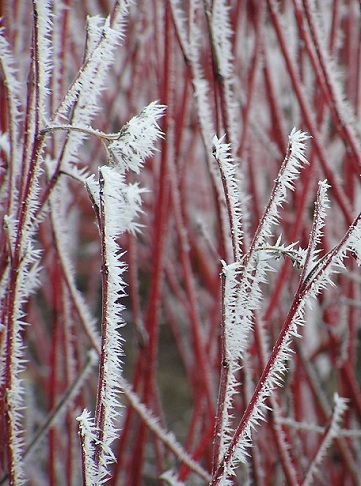
Red-Osier Dogwood
(Cornus sericea ssp. stolonifera)

Title
page of the book,
Hesperides, by Robert
Herrick dated 1648 |
From Jennifer, December
02, 2005
Isn't it a wonderful time of year? Today I went into
a building that was built in the late 1800's. As I walked in the door I was
taken back to another time.
The large foyer was decorated for the holidays
with just the right touch. On either side, a living tree was clothed in tiny
white lights. Each tree was placed in a big basket. There was an ornate banister
accompanying the stairway to the second floor with pine branches twined all
along and a big cluster or pine cones and ribbons at each landing. Such beauty
from natural materials, simply adorned.
Forget about the big figures that talk and sing,
flash and blink and play scratchy recordings of "ho ho ho."
What I saw today was, for me, a holiday scene of
style and grace to bring wonder to the heart of any child.
|
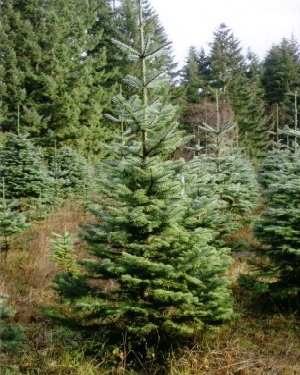 |
From Jennifer, November
25, 2005
Sometimes nature gets creative and decides to make a
new kind of plant. Such an occurrence happened many years ago when, for some
reason, the Alaska Cedar (Chamaecyparis nootkatensis) and the Monterey Cypress
(Cupressus macrocarpa) morphed into a brand new plant, the Leland Cypress
(Cupressocyparis leylandii).
This natural hybrid species is fast growing (gets
to 55 or 60 feet in 25 years). It's not particular about soil but it wants full
sun. It is hardy to USDA zone 7.
Highly recommended for fast growing hedges.
However, be warned that a Leland Cypress hedge can get out of hand in a hurry if
not pruned regularly while in the active growth stages. Though the average
height of the mature tree is 55 to 60 feet, when young they can grow 3 feet a
year. There are specimens in England's Kew Garden that are 120 feet tall!
Consider using the Leland Cypress as a unique
holiday tree before planting out. Very fragrant and tidy, this tree will not
mind being indoors for a week to 10 days. Choose a place in the home away from
heat sources.
|

Photo credit: Berean Hunter |
From Jennifer,
August 20, 2005
The "winter of no winter" is how we may come to refer
to this past winter. Plants here in the northwest are confused and it seems that
few are behaving in typical fashion.
Here in the Willamette Valley this confusion is
greatly in evidence in our
Vine Maple trees (Acer circinatum).
Some Vine Maples are dropping Fall leaves right now, in mid August - others are
not.
If we have a normal winter with freezing, I
suspect these trees will get back to normal. But for right now, wait and see.
|
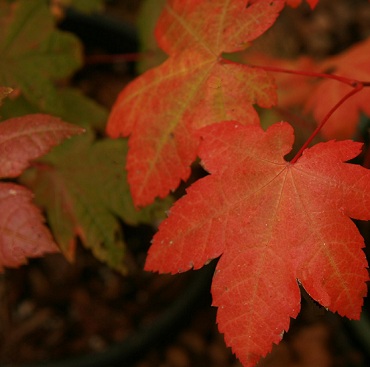 |
|
From Jennifer,
August 5, 2005
"Summertime, and the livin' is easy . . . " --- Such a
wonderful old song* and if your garden is full of well-established native
plants, this could be your favorite tune! It's true because only northwest
native plants are naturally comfortable in the climate and conditions of the
northwest. Imagine, very little watering or pruning or even cleanup in a
well-designed native garden.
If you're not familiar with xeriscaping and the use
of native plants in the landscape, you're working way too hard at keeping your
yard in good shape. No yard? Try a native container planting--beautiful!
*Summertime was written by George and Ira Gershwin
for the folk opera, Porgy and Bess in 1934. It was based on a novel, Porgy, by
DuBose Heyward.
|
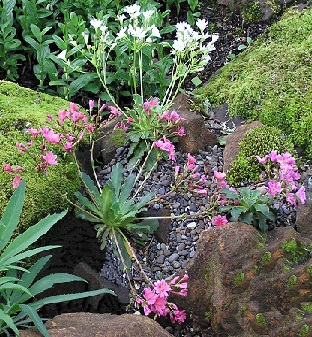 |
|
h
2004
h |
|
From Jennifer, July 23,
2004
Summer in the Mountains by Li Po
Gently I stir a white feather fan,
With open shirt sitting in a green wood.
I take off my cap and hang it on a jutting stone;
A wind from the pine-tree trickles on my
bare head.
Li T'ai-po tr. Waley
|
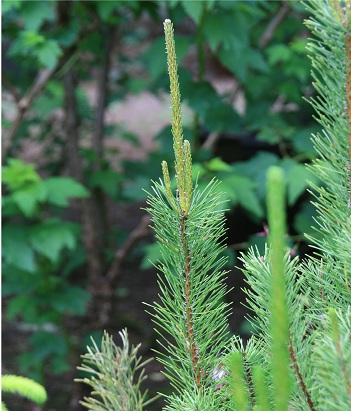 |
|
h
2003
h |
From Jennifer, November
28, 2003
This week brings one day especially dedicated to
appreciation and thankfulness for all the wonders we enjoy in our lives. Visions
of pilgrims and turkeys (or tofurkeys) may come to mind, or we may think of the
First Peoples who welcomed those who made the journey to new shores.
We think it's a most appropriate time to realize
that the native plants we grow are the same plants those long-ago folk saw every
day. What a wonderful world!
Share some wonder with people you meet. Share food
and clothing and things that keep us alive, but share the wonder and smiles and
joy as well.
Thanksgiving
by Joyce Kilmer
(For John Bunker)
The roar of the world is in my
ears.
Thank God for the roar of the world!
Thank God for the mighty tide of fears
Against me always hurled!
Thank God for the bitter and
ceaseless strife,
And the sting of His chastening rod!
Thank God for the stress and the pain of life,
And Oh, thank God for God!
|
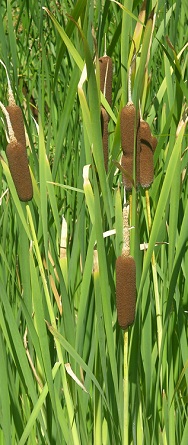 |
From Jennifer, November
14, 2003
Enjoy the changing scenery wherever you are. Notice
the plants and wildlife as you go about your daily travels. There is beauty
everywhere and surprises await around every corner!
Just this week, we've seen deer, squirrels, red-tailed hawks, quail, and a
housecat on the hunt in the middle of a field of grass. The maples have turned
hues of scarlet and gold, the oaks are becoming bronze, the rose hips are red
and juicy--just the ticket for a hungry bird.
Don't miss the precious views nature affords. Life
is short. Enjoy every minute!
|
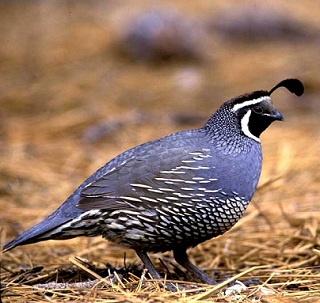 |
From Jennifer, October 18, 2003
Each season on our planet comes with it's special
stars in the plant world. Spring is a time of blooming pastels and delicate
petals (Indian Plum, trillium), Summer has lush greenery and vibrant flowers
(dogwoods and lilies), Winter has the pine cones and winter berries (pines,
cedars, snowberry), but fall has the changing leaves that magically go from
green to gold and scarlet and orange and brown.
Take your time and enjoy the natural beauty of our northwest native plants.
Notice the dogwoods and maples and the mighty oaks. Watch for seed pods of Cow
Parsnip. Have the wild rose hips turned red yet? You will find great delight in
viewing nature's phenomena of autumn glory.
|
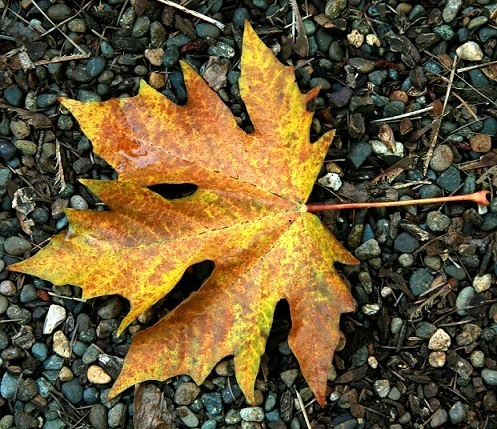 |
From Jennifer, August 21, 2003
August seems a long way from spring. The summer sun
is hot and makes us inclined to lie in a hammock and watch the clouds roll by. A
daydream about springtime native flowers might be a refreshing change!
Spring Pools
by Robert Lee Frost
These pools that, though in forests, still reflect
The total sky almost without defect,
And like the flowers beside them, chill and shiver,
Will like the flowers beside them soon be gone,
And yet not out by any brook or river,
But up by roots to bring dark foliage on.
The trees that have it in their pent-up buds
To darken nature and be summer woods --
Let them think twice before they use their powers
To blot out and drink up and sweep away
These flowery waters and these watery flowers
From snow that melted only yesterday.
|
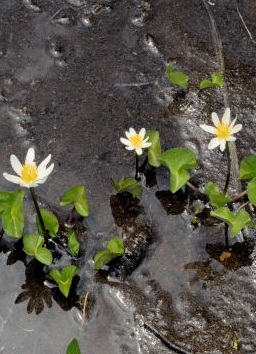
Alpine Marsh Marigold
(Caltha leptosepala)
Photo
credit: Paul Knoll |
|
From Jennifer, July 24,
2003
Native bulbs and rhizomes are magical elements of the landscape. They live
quietly underground in very little space, yet when it is time for them to appear
they do so with much fanfare and flourish.
The Tiger
Lilies (Lillium columbianum) have
just finished blooming. They begin with a whorl of lime-green leaves from which
the flower stalk rises from 2-4' tall. Each stalk carries clusters of delicate
2" orange flowers with recurving petals, reminding one of the curved slippers
worn in India. Tiger Lilies prefer their bases in the shade of other plants and
their graceful ballerina flowers in the sun. Hardy in USDA zones 5-10, they do
remarkably well in the garden.
Native Western
Trillium or Wakerobin (Trillium ovatum) is
the most common trillium in the Northwest. We call them the natural Easter lily
because they naturally bloom right about that time, no forcing or manipulation
required. Wally often refers to groups of trilliums as little woodland nuns,
their pristine blooms look like hats as they bob in the spring breezes. Trillium
are hardy USDA zones 5-8.
Sessile Trillium or Smallflower Wakerobin (Trillium parviflorum) are
found in Marion and Polk counties in Oregon and are close to rare status.
Partial to shade and moist soil, the flowers of Sessile Trillium sit directly on
the three leaves instead of on little stems as do the Western Trilliums. Their
leaves are somewhat mottled and often larger than those of Western Trillium.
Their white bloom changes to purple with age, an added surprise in the garden.
Fawn Lily (Erythronium oreganum) blooms
with pale yellow flowers like little fairy ballerinas. The interesting mottled
leaves are lovely in the landscape present the flower stalks up to 1' tall.
These lilies self-seed generously but it takes many years for the seedlings to
mature to flowering plants. One must be patient and enjoy each bloom as it
comes. An excellent garden addition, hardy in USDA zones 7-9.
|
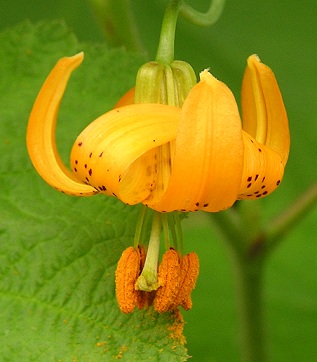
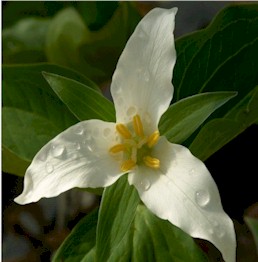 |
|
From Jennifer, February
6, 2003
In winter, the shorter days and less frequent sunshine can seem a little bleak
and drear. Our thoughts are on tax preparation and budget cuts and the
consideration of strife in the world. Although the outlook for our future is not
rose-coloured, neither is it dark. It is simply unknown. But that's the way it
has always been. We do not know what tomorrow will bring.
We shall set our hearts to an inner peace and plant a tree--a big tree--for as
that tree grows and thrives, so shall our lives. And our spirits will soar
through it's branches.
Peace
by Sarah
Teasdale
Peace flows into me
As the tide to the pool by the shore;
It is mine forevermore,
It will not ebb like the sea.
I am the pool of blue
That worships the vivid sky;
My hopes were heaven-high,
They are all fulfilled in you.
I am the pool of gold
When sunset burns and dies --
You are my deepening skies;
Give me your stars to hold.
|

This Coast Redwood, Sequoia
sempervirens, can grow to
be the largest tree in
the whole wide world.
Photo
credit: Acroterion |
|
h
2002
h |
From Jennifer, November
28, 2002
Today in the United States we pause to celebrate all
the things for which we are thankful. Mother nature has been very generous in
her gifts of beauty and grace found in native plants.
Be Thankful
Author Unknown
Be thankful that you don't already
have everything you desire.
If you did, what would there be to look forward to?
Be thankful when you don't know everything,
for it gives you the opportunity to learn.
Be thankful for the difficult times.
During those times you grow.
Be thankful for your limitations,
because they give you opportunities for improvement.
Be thankful for each new challenge
because it will build your strength and character.
Be thankful for your mistakes.
They will teach you valuable lessons.
Be thankful when you're tired and weary,
because it means you've made a difference.
We wish you all a joyful and pleasant Thanksgiving
|
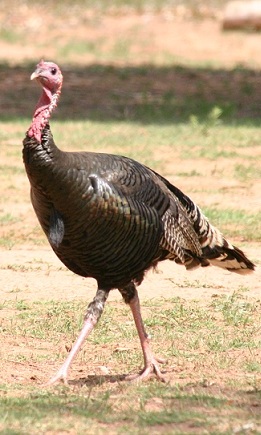
Wild Turkey
(Meagris
gallopavo intermedia)
Photo credit:
Wing-Chi Poon |
From Jennifer, September 13, 2002
Autumn has always been a magical time for me. About
the middle of September, I call the season "Indian Summer" (even though
traditionally Indian Summer is in October or November) and I begin to shrug off
the malaise that covers me in late summer when the days are hot and the air is
still.
When Indian Summer comes, the morning sun dawns
purple in the smoky sky, the geese begin sounding their flight plans and there
is an unmistakable change in the atmosphere that brings energy to my heart.
The leaves turn colors, autumn berries are
evident, rose hips redden and I can't wait to find my first chanterelle of the
year.
|
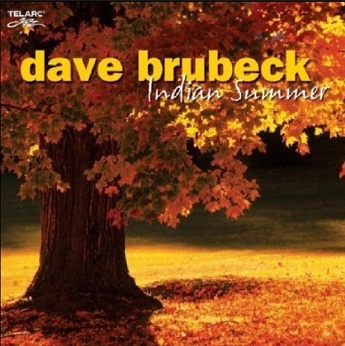 |
From Wally,
May 17, 2002
Picture being in a woodland meadow plucking
salmonberries or
thimbleberries or
red huckleberries from the
shrubs and savoring their sun-warmed juicy goodness. The delicious impromptu
picnic is accompanied by birds flitting around nearby, singing their odes to
summer's bounty. One can almost feel the sun's caress in this poignant scene.
Now picture this same scene unfolding in your own yard. You can plant these
northwest native berries in your landscape or special wildlife habitat and bring
the sweet taste of the wild just outside your door. That's a picture you can
re-create for years to come.
Oh! The joy of huckleberry pie! My very favorite berry since I was a child,
huckleberry's flavor is unique and quite wonderful. Or perhaps a handful of
salmonberries sprinkled over your morning bowl of cereal would tempt your
tastebuds. Whichever berry you add to your yard will give it's two-fold gift of
botanical beauty paired with gastronomical delight.If berries are not your "cup of tea," consider adding them to your wildlife
habitat. The birds and other wildlife will appreciate your thoughtfulness and
care in providing them sweet summer food.
|
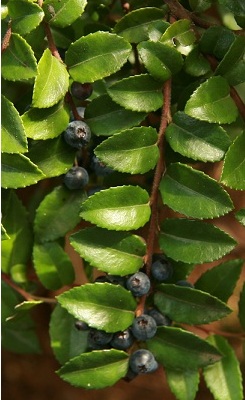 |
From
Wally,
April 27, 2002
A gentle rain is falling as I write this. The Nursery and Gardens look so much
different on a rainy day as the dogwood flowers are misted with sparkling drops.
When the sun is shining the meadow is golden and shafts of sunlight pierce the
boughs of the trees overhead, creating spotlights on the plants below. But when
the Springtime rain falls, the Nursery and Gardens become a magical place where
I think I can catch a glimpse of a fairy as she peeps around a leaf to watch
me--well, almost.
If you're of a mind to have an adventure, come to the Nursery and Gardens on a
Spring morning when the gentle rains are falling. Wear a light jacket and bring
an umbrella or a hat!
|

This is the Morton Salt girl from 1921 |












































